初中英语教学案例分析
英语教学案例分析 (菁选最新4篇
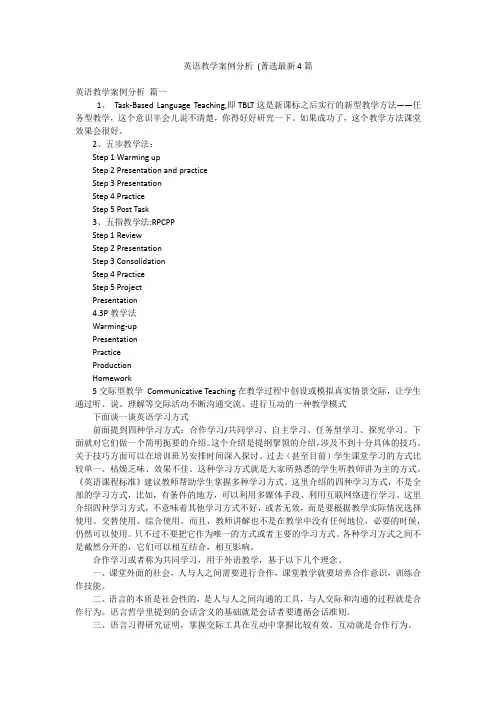
英语教学案例分析(菁选最新4篇英语教学案例分析篇一1、Task-Based Language Teaching,即TBLT这是新课标之后实行的新型教学方法——任务型教学,这个意识半会儿说不清楚,你得好好研究一下。
如果成功了,这个教学方法课堂效果会很好。
2、五步教学法:Step 1 Warming upStep 2 Presentation and practiceStep 3 PresentationStep 4 PracticeStep 5 Post Task3、五指教学法:RPCPPStep 1 ReviewStep 2 PresentationStep 3 ConsolidationStep 4 PracticeStep 5 ProjectPresentation4.3P教学法Warming-upPresentationPracticeProductionHomework5交际型教学Communicative Teaching在教学过程中创设或模拟真实情景交际,让学生通过听、说、理解等交际活动不断沟通交流、进行互动的一种教学模式下面谈一谈英语学习方式前面提到四种学习方式:合作学习/共同学习、自主学习、任务型学习、探究学习。
下面就对它们做一个简明扼要的介绍。
这个介绍是提纲挈领的介绍,涉及不到十分具体的技巧。
关于技巧方面可以在培训班另安排时间深入探讨。
过去(甚至目前)学生课堂学习的方式比较单一、枯燥乏味、效果不佳。
这种学习方式就是大家所熟悉的学生听教师讲为主的方式。
《英语课程标准》建议教师帮助学生掌握多种学习方式。
这里介绍的四种学习方式,不是全部的学习方式,比如,有条件的地方,可以利用多媒体手段、利用互联网络进行学习。
这里介绍四种学习方式,不意味着其他学习方式不好,或者无效,而是要根据教学实际情况选择使用、交替使用、综合使用。
而且,教师讲解也不是在教学中没有任何地位,必要的时候,仍然可以使用。
英语教学案例分析(精选5则)
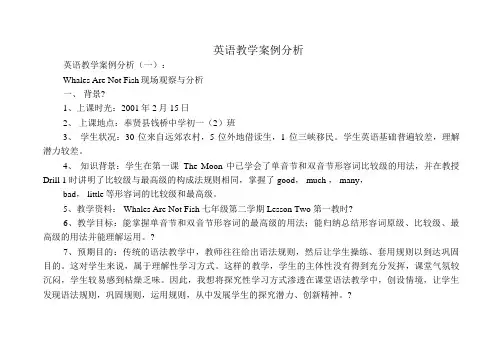
英语教学案例分析英语教学案例分析(一):Whales Are Not Fish现场观察与分析一、背景?1、上课时光:2001年2月15日2、上课地点:奉贤县钱桥中学初一(2)班3、学生状况:30位来自远郊农村,5位外地借读生,1位三峡移民。
学生英语基础普遍较差,理解潜力较差。
4、知识背景:学生在第一课The Moon 中已学会了单音节和双音节形容词比较级的用法,并在教授Drill 1 时讲明了比较级与最高级的构成法规则相同,掌握了good, much , many,bad, little等形容词的比较级和最高级。
5、教学资料: Whales Are Not Fish 七年级第二学期Lesson Two 第一教时?6、教学目标:能掌握单音节和双音节形容词的最高级的用法;能归纳总结形容词原级、比较级、最高级的用法并能理解运用。
?7、预期目的:传统的语法教学中,教师往往给出语法规则,然后让学生操练、套用规则以到达巩固目的。
这对学生来说,属于理解性学习方式。
这样的教学,学生的主体性没有得到充分发挥,课堂气氛较沉闷,学生较易感到枯燥乏味。
因此,我想将探究性学习方式渗透在课堂语法教学中,创设情境,让学生发现语法规则,巩固规则,运用规则,从中发展学生的探究潜力、创新精神。
?二、设计意图、教学片段及诊断分析“探究性学习”强调的是以学生为主体,问题为中心,研究为手段,实践为途径,过程体验重点,创新精神和实践潜力培养为目的的一种学习方式。
在本课设计时,我力求将上述特征体此刻课堂教学中。
我发现,研究性学习实施时三个相互交叉推进的阶段-进入问题情景、实践体验、表达和交流与外语教学“3P模式(Presentation -Practice-Production)”是相通的。
因此,我在Presentation这一阶段中,从身边的事物出发,创设情境,引出最高级,激发学生探求最高级使用规则的欲望并归纳总结(即发现、探究问题)。
在Practice这一阶段中,我让学生前后联系,构成形容词三种形式用法的知识网络,并探求相应的记忆策略,然后操练(即探究、实践问题)。
初中英语教学案例分析集合3篇
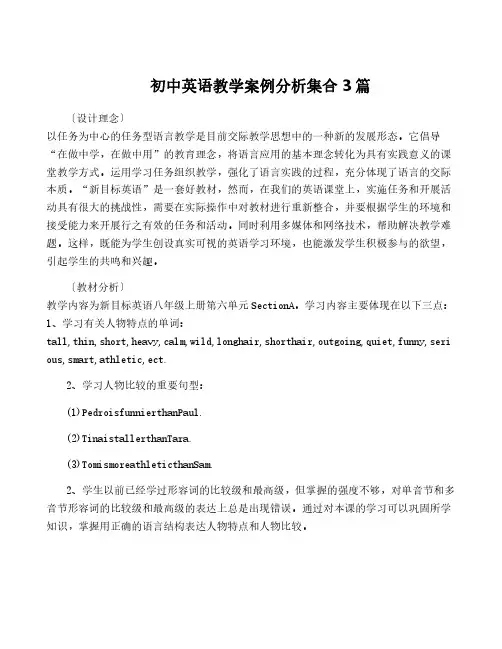
初中英语教学案例分析集合3篇〔设计理念〕以任务为中心的任务型语言教学是目前交际教学思想中的一种新的发展形态。
它倡导“在做中学,在做中用”的教育理念,将语言应用的基本理念转化为具有实践意义的课堂教学方式。
运用学习任务组织教学,强化了语言实践的过程,充分体现了语言的交际本质。
“新目标英语”是一套好教材,然而,在我们的英语课堂上,实施任务和开展活动具有很大的挑战性,需要在实际操作中对教材进行重新整合,并要根据学生的环境和接受能力来开展行之有效的任务和活动。
同时利用多媒体和网络技术,帮助解决教学难题。
这样,既能为学生创设真实可视的英语学习环境,也能激发学生积极参与的欲望,引起学生的共鸣和兴趣。
〔教材分析〕教学内容为新目标英语八年级上册第六单元SectionA。
学习内容主要体现在以下三点:1、学习有关人物特点的单词:tall,thin,short,heavy,calm,wild,longhair,shorthair,outgoing,quiet,funny,seri ous,smart,athletic,ect.2、学习人物比较的重要句型:(1)PedroisfunnierthanPaul.(2)TinaistallerthanTara.(3)TomismoreathleticthanSam.2、学生以前已经学过形容词的比较级和最高级,但掌握的强度不够,对单音节和多音节形容词的比较级和最高级的表达上总是出现错误。
通过对本课的学习可以巩固所学知识,掌握用正确的语言结构表达人物特点和人物比较。
〔教学目标〕1、谈论学生感兴趣的话题,指导学生学习有关人物特点的单词、人物比较的表达及语法知识点“形容词的比较级和最高级”。
2、学生根据班级的真实情况,采用“名人专访”、“公众投票”、“明日之星”的游戏,培养学生的想象力、自信心和合作精神。
3、通过学习本课,增强师生、生生间的相互了解和沟通。
4、培养学生的口头表达能力、阅读理解能力和写作能力。
英语教学案例分析范文6篇初中
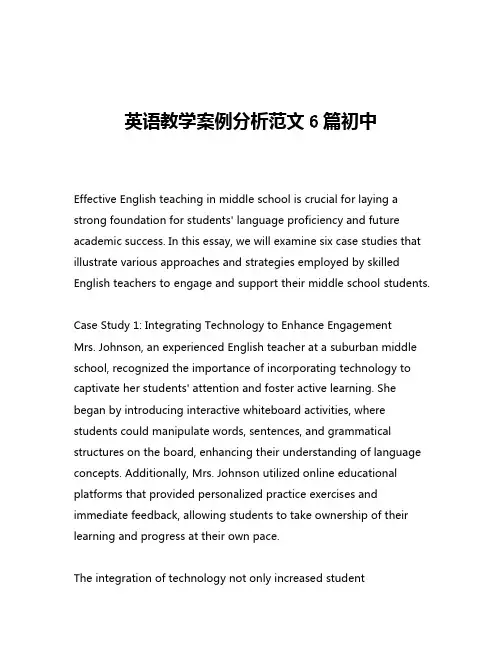
英语教学案例分析范文6篇初中Effective English teaching in middle school is crucial for laying a strong foundation for students' language proficiency and future academic success. In this essay, we will examine six case studies that illustrate various approaches and strategies employed by skilled English teachers to engage and support their middle school students.Case Study 1: Integrating Technology to Enhance Engagement Mrs. Johnson, an experienced English teacher at a suburban middle school, recognized the importance of incorporating technology to captivate her students' attention and foster active learning. She began by introducing interactive whiteboard activities, where students could manipulate words, sentences, and grammatical structures on the board, enhancing their understanding of language concepts. Additionally, Mrs. Johnson utilized online educational platforms that provided personalized practice exercises and immediate feedback, allowing students to take ownership of their learning and progress at their own pace.The integration of technology not only increased studentengagement but also enabled Mrs. Johnson to differentiate instruction and cater to diverse learning styles. Students who struggled with traditional pen-and-paper exercises found the digital activities more appealing and accessible, while those who thrived on independent learning benefited from the self-paced nature of the online resources. The result was a more dynamic and inclusive classroom environment, where all students felt empowered to participate and succeed in their English studies.Case Study 2: Fostering Critical Thinking through Literature Circles Mr. Patel, a middle school English teacher in a diverse urban setting, recognized the importance of developing his students' critical thinking skills. He implemented a literature circles approach, where students were divided into small groups and assigned different roles, such as discussion leader, connector, and literary analyst. Each group was responsible for reading a selected work of literature and engaging in collaborative discussions to unpack the themes, characters, and literary devices.The literature circles not only encouraged active engagement with the text but also cultivated essential communication and problem-solving skills. Students learned to listen actively, express their ideas clearly, and consider multiple perspectives. Mr. Patel's role shifted from a traditional lecturer to a facilitator, guiding the discussions and prompting students to delve deeper into the literary analysis.The success of this approach was evident in the students' increased confidence in expressing their interpretations and the depth of their literary analysis. Additionally, the collaborative nature of the literature circles fostered a sense of community and camaraderie among the students, further enhancing their overall learning experience.Case Study 3: Integrating Authentic Cultural ExperiencesIn a middle school with a growing population of English language learners, Ms. Garcia recognized the importance of incorporating authentic cultural experiences into her English lessons. She collaborated with the school's diversity committee to organize cultural celebrations and invite guest speakers from various backgrounds to share their stories and traditions.During these events, students had the opportunity to engage with the English language in a meaningful and contextual manner. They learned vocabulary and expressions related to the featured cultures, participated in interactive activities, and gained a deeper appreciation for the diversity within their school community. The cultural experiences also served as a platform for students to practice their speaking and listening skills in a low-stress, authentic setting.The integration of authentic cultural experiences not only improvedthe English language proficiency of the English language learners but also fostered a greater sense of inclusion and understanding among all students. The cross-cultural exchange and exposure to diverse perspectives enriched the learning environment and contributed to the overall growth and development of the students.Case Study 4: Differentiated Instruction for Struggling Readers Mrs. Nguyen, a middle school English teacher in a high-needs district, recognized the diverse learning needs of her students, particularly those who struggled with reading comprehension. She implemented a multi-tiered system of support, where she provided targeted interventions and differentiated instruction to address the individual needs of her students.For students who required additional support, Mrs. Nguyen utilized research-based reading strategies, such as guided reading, vocabulary development, and explicit instruction in phonics and fluency. She also incorporated the use of audiobooks, text-to-speech software, and graphic organizers to help struggling readers access the content and actively engage with the material.Mrs. Nguyen's dedication to differentiated instruction paid off, as her struggling readers demonstrated significant improvements in their reading abilities and overall academic performance. The individualized attention and tailored support not only boosted theirconfidence but also instilled a love for reading and learning.Case Study 5: Integrating Project-Based LearningMr. Goldstein, a middle school English teacher in a suburban setting, recognized the importance of making the English curriculum more relevant and engaging for his students. He implemented a project-based learning approach, where students were tasked with creating multimedia presentations on topics of their choice, ranging from social issues to literary analyses.The project-based learning approach allowed students to take an active role in their learning, as they conducted research, synthesized information, and utilized various technological tools to present their findings. Mr. Goldstein provided guidance and feedback throughout the process, ensuring that students developed essential skills, such as critical thinking, problem-solving, and effective communication.The project-based learning activities not only enhanced the students' engagement and motivation but also fostered their ability to collaborate, think creatively, and apply their knowledge to real-world situations. The final presentations showcased the students' diverse talents and perspectives, further enriching the learning environment.Case Study 6: Integrating Interdisciplinary ConnectionsMs. Lim, a middle school English teacher in a STEM-focused school,recognized the importance of integrating interdisciplinary connections to make the English curriculum more relevant and meaningful for her students. She collaborated with her colleagues from the science, mathematics, and social studies departments to develop cross-curricular lessons and projects.For example, in a unit on persuasive writing, Ms. Lim worked with the science teacher to have students research and write persuasive essays on environmental issues. The students not only honed their English language skills but also deepened their understanding of scientific concepts and their real-world applications. Similarly, in a poetry unit, Ms. Lim partnered with the art teacher to have students create visual representations of their poems, fostering their creativity and artistic expression.The integration of interdisciplinary connections not only enhanced the relevance and depth of the English curriculum but also encouraged students to see the interconnectedness of different subject areas. This approach helped students develop a more holistic understanding of the world around them and the role of language in various disciplines.In conclusion, the six case studies presented in this essay demonstrate the diverse and effective strategies employed by skilled English teachers in middle school settings. From integratingtechnology to fostering critical thinking, incorporating authentic cultural experiences, differentiating instruction, implementing project-based learning, and making interdisciplinary connections, these teachers have created dynamic and inclusive learning environments that support the academic and personal growth of their students. The success of these approaches underscores the importance of continuous professional development, collaboration, and a student-centered approach to English language instruction in middle schools.。
初中英语案例分析
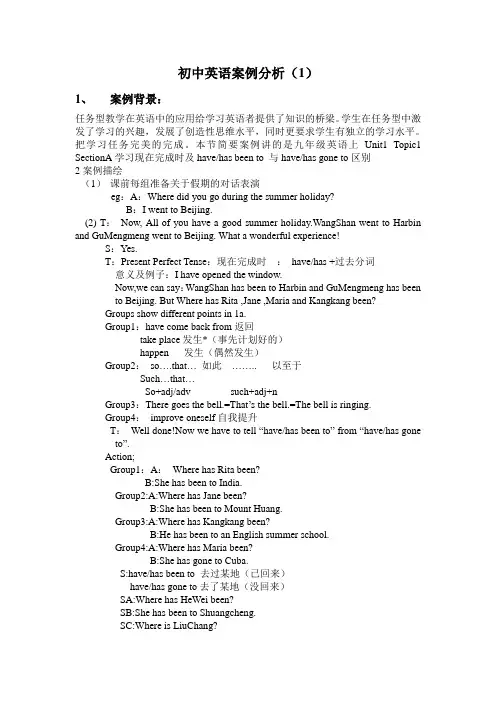
初中英语案例分析(1)1、案例背景:任务型教学在英语中的应用给学习英语者提供了知识的桥梁。
学生在任务型中激发了学习的兴趣,发展了创造性思维水平,同时更要求学生有独立的学习水平。
把学习任务完美的完成。
本节简要案例讲的是九年级英语上Unit1 Topic1 SectionA学习现在完成时及have/has been to 与have/has gone to区别2案例描绘(1)课前每组准备关于假期的对话表演eg:A:Where did you go during the summer holiday?B:I went to Beijing.(2) T:Now, All of you have a good summer holiday.WangShan went to Harbin and GuMengmeng went to Beijing. What a wonderful experience!S:Yes.T:Present Perfect Tense:现在完成时:have/has +过去分词意义及例子:I have opened the window.Now,we can say:WangShan has been to Harbin and GuMengmeng has beento Beijing. But Where has Rita ,Jane ,Maria and Kangkang been?Groups show different points in 1a.Group1:have come back from返回take place发生*(事先计划好的)happen 发生(偶然发生)Group2:so….that…如此…….. 以至于Such…that…So+adj/adv such+adj+nGroup3:There goes the bell.=That’s the bell.=The bell is ringing.Group4:improve oneself自我提升T:Well done!Now we have to tell “have/has been to” from “have/has goneto”.Action;Group1:A:Where has Rita been?B:She has been to India.Group2:A:Where has Jane been?B:She has been to Mount Huang.Group3:A:Where has Kangkang been?B:He has been to an English summer school.Group4:A:Where has Maria been?B:She has gone to Cuba.S:have/has been to 去过某地(已回来)have/has gone to去了某地(没回来)SA:Where has HeWei been?SB:She has been to Shuangcheng.SC:Where is LiuChang?SD:She has gone to the teacher’s office.SE:When will she come back?SF:She will come back in five minutes.Finish 2in Groups.Homework: The differences between the simple past tense and present perfect tense. 案例评析:任务型教学目的让学生脱离教材,在乐中学,有任务而学习。
初中英语教学案例分析

初中英语教学案例分析一、案例背景在初中英语教学中,教师往往会遇到各种各样的案例,例如学生学习兴趣不高、成绩不理想、听力表达能力弱等等。
本文将通过一个真实案例来进行分析,提出解决问题的方法和建议。
二、案例描述某初中七年级学生小王,英语学习成绩一直不理想,经常在课堂上注意力不集中,成绩也不好。
教师发现他对英语学习兴趣不高,缺乏自信心,对学习没有目标。
在听力和口语方面也表现较差,不愿意主动参与课堂讨论和互动。
三、案例分析1. 缺乏学习兴趣:小王缺乏对英语学习的兴趣,可能是因为学习方法单一、教学内容枯燥等原因导致的。
2. 缺乏自信心:小王对自己的英语能力不自信,可能是因为平时缺乏实践和表达机会,导致他对英语学习产生了畏难情绪。
3. 听力口语能力差:小王在听力和口语方面表现较差,可能是因为平时缺乏练习和交流机会,无法熟练掌握相关技能。
四、解决方法和建议1. 激发学习兴趣:教师可以采用多种形式的教学方法,例如游戏、歌曲、小组合作等,让学生在轻松愉快的氛围中学习英语,激发他们的学习兴趣。
2. 提高自信心:教师可以给予学生更多的肯定和鼓励,让学生在教学中有更多的表现机会,并且可以提供更多的口语练习和表达机会,提高学生的自信心。
3. 加强听力口语训练:教师可以为学生提供更多的听力练习和口语交流机会,鼓励学生多参与课堂讨论和互动,提高他们的听力口语能力。
五、案例效果评估通过以上方法和建议的实施,小王在英语学习方面表现出了明显的改善。
他的学习兴趣得到了激发,对英语学习充满了热情,成绩也有了提高。
他的自信心得到了提高,愿意在课堂上积极表达和参与。
听力口语能力也有了明显的提高,能够更加流利地进行英语交流。
六、结论以上案例分析表明,对于初中英语教学中出现的学生问题,教师应该针对性地采取相应的方法和建议,解决学生学习中的困难。
只有通过差异化的教学方法和个性化的教学辅导,才能真正激发学生的学习兴趣,提高他们的学习效果。
希望本文的案例分析能够对教师们在英语教学中提供一些参考和借鉴。
初中英语教学案例分析
初中英语教学案例分析一、教学背景分析教学案例:Unit 2 I’m from China.教学内容:地理国籍介绍教学目标:1.学会用英文自我介绍,并向别人简单介绍自己的国籍。
2.学会用英文询问其他人的国籍。
教学方法:听说结合;小组合作;活动设计详细教学步骤:1.显示地图和国旗海报,引入新课。
2. 听力训练:播放“Where are you from?”音频,让学生听音并尝试回答问题。
3.听力训练:播放关于多个国家的录音,让学生听音并回答问题。
4.观察国旗图片,了解不同国家的国籍。
5. 听力训练:播放“Where is he/she from?”音频,让学生听音并回答问题。
6.听力训练:播放关于人物的录音,让学生听音并回答问题。
7.听力训练:播放对话录音,让学生判断句子正误,并回答问题。
8.听说互动活动:将学生分成小组,用英文介绍自己的国籍,并询问其他组成员的国籍。
9.听说互动活动:将学生分成小组,假设自己来自不同的国家,用英文进行对话,互相介绍并询问国籍。
10.语法练习:介绍英文国家名的构成规则,让学生用国家名填空。
11.综合训练:运用所学知识,编写对话,介绍不同国家的人来中国旅游。
12.小结:总结本课的学习内容和所学到的知识。
三、教学效果评价通过教学案例分析可看出,本课设计了多种听说互动教学活动,培养了学生的听力理解能力和口语表达能力,使他们能够自信地用英文介绍自己的国籍和询问他人的国籍。
除此之外,还通过语法练习和综合训练,拓展了学生对国家名的记忆和运用能力。
整个教学过程紧凑有序,注重了视听结合和小组合作,培养了学生的学习兴趣和团队合作能力。
四、教学反思与改进本课中,教学方法灵活多样,但在听力训练环节中可能存在一些问题,学生对录音理解可能不够准确,需要加强训练。
此外,综合训练环节设计的对话内容可以更具有实践性,让学生能够真实运用英文进行交流。
同时,在小结环节可以给学生更多自主学习的机会,提高学生的思考和总结能力。
初中英语教学案例分析
初中英语教学案例分析
教学案例一:话题讨论课——“健康饮食”
1. 教案主题:健康饮食
2. 教学目标:
(1)能够了解健康饮食的概念与重要性,认识食物分类及其对人体的影响;
(2)能够掌握如何选择健康饮食,了解食物的搭配和数量;
(3)能够提高学生们的口语表达和团队合作能力;
(4)能够提高学生们的实践能力和学习方法。
(1)健康饮食的概念与重要性
(2)食物的分类及其对人体的影响
(1)导入环节
教师将课程的主题告知学生,并让学生们在小组之间互相交流,在课堂后期进行讨论,且在学生之间共享自己的发言。
(2)学习活动
教师先让学生了解什么是健康饮食及其重要性,让学生自己思考,然后教师补充和讲解。
教师给学生出示一张图片,可以将贴在黑板上的图片打印出来,让学生们以小组为单位,就这些食品进行讨论;然后再让学生们汇报小组中的观点。
教师让学生自己想想食物怎么分类,然后以小组为单位讨论,让学生自己提出观点,
再由教师在黑板上归纳总结;然后教师就食物分类中的每一类食物的代表性生产和作用讲解,学生跟随着一起获得知识。
教师再出示几张食品补充类的图片,分组来讨论如何选择健康饮食和食物的搭配,并
就搭配提出建议,让学生们思考自己的所作所为,让他们反思自己的饮食习惯。
(3)总结讲解环节
教师让学生交流讨论的情况,并对本节课的学习结果进行总结。
在本节课的学习中,学生们能够充分发挥自己的思维能力,在小组内热烈讨论,提高
了口头表达能力和思考能力。
而且,通过这种方式,学生们充分体验了与他人分享知识和
团队协作的乐趣。
此外,教师通过提出具体的例子和实际操练了学生们的实践能力和解决问题的能力。
初中英语课例分析(共5篇)
初中英语课例分析(共5篇)第一篇:初中英语课例分析初中英语课例分析(圣诞节)一、课文简介:本课题目是“圣诞节”,是一篇阅读文章。
本课围绕庆贺节日的话题展开各项语言活动,其主要交际功能项目为圣诞节和新年的节日问候。
英语新课程标准中要求学生掌握的表达祝愿及问答的日常用语大部分在本课都有所体现。
本课介绍了西方国家庆祝圣诞活动、圣诞老人的故事以及基督精神。
学生通过学习,掌握有关圣诞节的词汇,了解西方国家的“圣诞文化”,加深对基督精神的理解,并能向别人介绍圣诞节。
二、学生分析:初三学生经过两年的初中英语学习,有了初步的阅读能力,能借助于词典正确理解课文,庆祝圣诞情况也略知一二。
他们也有能力通过网络查询有关信息。
此阶段的学生还具有较强的“自我”发展意识,对具有一定知识性及历史背景的语言材料表现出浓厚的兴趣。
三、教学目标及对应的课程标准: 1.语言知识目标:学生能够根据音标正确读出、记住kind-hearted等14个单词,了解它们的词性、语法功能及体现于词汇中特殊的文化含义;掌握even though等15个词组的用法,会使用这些词汇描述圣诞节庆祝活动,会正确使用近义词。
2.语言技能目标:听:能听懂本课录音,并回答有关问题。
说:能正确描述有关圣诞活动。
读:能读懂难易程度与课文相当的短文。
写:能以圣诞为题写一篇100字的短文。
3.情感态度目标:具有积极向上的学习态度,乐于进行小组合作,不懂不会之处,主动寻求帮助,积极举手回答问题,积极探究问题,不断提高学习英语的积极性和自信心。
4.学习策略:积极预习,复习课文,思考问题,记好笔记,在学习中大胆联想,学会运用知识。
大胆与同学用英语交流,积极思考问题,掌握重点难点,学会运用速读、细读技巧阅读文章。
学会正确运用词汇描述事物,熟悉西方主要节日的庆典活动。
积极利用媒体、资料、网络资源辅助学习,探讨问题,开拓视野,拓宽知识面。
5.文化意识:“圣诞”是西方文化的奠基。
了解“圣诞”有助于学好英语并理解西方文化。
初中英语教学案例分析100例
初中英语教学案例分析100例第一例:教学目标的设置案例描述:在一堂初中英语课上,老师要求学生掌握并运用动词的过去式形式。
老师使用了多种教学方法,并设计了丰富的练习和活动。
然而,学生们在课堂上仍然存在理解和应用不够准确的问题,表现出较大的困惑。
在分析原因后,老师发现可能出现了目标设置不合理的问题。
分析: 1. 目标过于宽泛:老师没有明确指出需要学生掌握哪些动词的过去式形式,导致学生对学习的范围模糊,不知道应该重点掌握哪些内容。
2. 目标过于笼统:老师只强调学生要掌握过去式形式,但没有具体阐述应用情境,导致学生不知道动词的过去式该在何种语境下使用,缺乏实际应用经验。
3. 目标未贴近学生的实际需求:老师并未引导学生思考为什么要学习动词的过去式,以及学习过程中可能遇到的问题和困惑。
这导致学生缺乏主动性和对学习的兴趣。
解决方案: 1. 目标明确:要求学生掌握十个常用动词的过去式形式。
2. 目标具体:引导学生应用过去式形式进行对话练习,提高用动词的过去式进行语言表达的准确性。
3. 目标关联实际:通过教材中的情境对话或真实场景进行角色扮演,让学生在实际交流中学习和运用动词的过去式。
4. 目标贴近学生需求:通过小组合作学习,鼓励学生彼此讨论和解答问题,激发学生学习的主动性和兴趣。
效果评估: 1. 运用命题方式的练习,通过考试、评分等方式评估学生对动词过去式的掌握程度。
2. 通过课堂观察和学生反馈,了解学生在学习过程中的困惑和进步。
第二例:教学方法的转变案例描述:一名初中英语老师发现学生对于课堂教学内容的兴趣不高,学习效果并不明显。
通过观察和反思后,老师意识到自己教学方法单一,缺乏创新,需要进行改进。
分析: 1. 老师主要采用传统的讲授、背诵和习题训练的教学方式,缺乏互动性和趣味性,不能激发学生的学习兴趣。
2. 学生在课堂上没有多次机会进行口语表达和互动,导致口语能力得不到有效提升。
3. 学生缺乏参与感,被动接受知识,没有充分发挥自主学习和合作学习的优势。
- 1、下载文档前请自行甄别文档内容的完整性,平台不提供额外的编辑、内容补充、找答案等附加服务。
- 2、"仅部分预览"的文档,不可在线预览部分如存在完整性等问题,可反馈申请退款(可完整预览的文档不适用该条件!)。
- 3、如文档侵犯您的权益,请联系客服反馈,我们会尽快为您处理(人工客服工作时间:9:00-18:30)。
初中英语教学案例分析新目标七年级上册Unit1 What's this in English?中心中学年月初中英语教学案例分析新目标七年级上册Unit1 What's this in English?[案例背景]本单元主要教学一些物品的名称,如:学习用品,服装,水果,家具等等。
要求学生能熟练的用下列句型进行交流。
A: What’s this in English?B: It’s a pen.A: Spell it, please.B: P_E_N, pen.本单元是七年级上册正式单元第一单元,位于26个字母学习完之后,字母的认读,单词的拼写,以及单词的读音也是本课的重点之一。
在课堂设计的过程中,考虑到这节课的具体情况:位于第一单元,单词量较少,句型相对简单,绝大多数学生都已在小学学过该句型,但是,由于所教班级的学生来自六个不同的乡村小学,英语基础较差,水平参差不齐,虽然他们在小学已经学过这部分内容,但是小学英语和初中英语的要求是不同的,他们对知识点的掌握程度还没有达到初中水平。
鉴于以上原因,我认为做为第一单元来说,激发、调动学生兴趣是关键,让学生人人都动起来主动参与到课堂活动中来,尝试着在任务型的活动中让学生自己教会自己的方法来建构自己的知识体系,从而完成这节课的教学。
教学过程中,结合我校的小组合作学习教学模式,我设计了学生动手绘画比赛,小组问答学习,组内调查统计等几个环节,环环相扣,由浅入深,逐步推进,让学生在参与各项活动中潜移默化地自然而然地学到了新知识。
课堂实践证明,这样的安排充分发挥了小组合作学习教学模式的优点,不仅调动了已经掌握了这部分知识的同学,让他们尝到了为人师的成就感和自豪感;与此同时,还让那些不会的同学有了更强烈的学习欲望,更多的学习机会,消除了师生之间的隔阂,让他们从自己的同学中学习,他们感到自然,易于接受。
达到了“兵教兵”的目的,这也不失为本节课的一大闪光点。
[案例描述]1.Objectives:a. Introduce some things in English and spell the new words to revise the letters.(Exlain:introduce these new things by reading and spelling)b. Most of the students would be able to use the article :a and an.( Exlain:the differences between them.)c.New words: what,is, this, in, English, spell, it,please, a, an, jacket, pen, ruler, map, key, quilt, it's(Exlain:read after the teacher)Method instruction:a. Cooperation learning : drawing competition----- draw four pictures (each team a picture about school things, fruit ,clothes and furniture (five minutes)b. show them in class. Then the teacher asked : What's this in English? Who knows? Please hands up! Then let the students who have learnt the new words answer the questions then ask them to teach the others .c.Let the whole class repeat the new words several times. ask students to pay attention to the article: a and and. Cooperation leaning: Make a survey; learn the English of the other thin gs they draw and write down the English names beside the things they drew. Agree them to ask the students in other groups if all the students in their gro up don't know the words.e. Show the words they write on the blackboard by projector。
Then lead t hem to make phrases like below:an apple, an orange, an egg,a pen, a ruler, a map, a quilt,...2. Focuses:i. the use of a, an.ii. the spelling and the sound of the new words.3. Difficulties:the usage of a and an4.Teaching aids:computer, paper, color pencils5. Teaching procedure:ⅠCheck the preparationⅡ leading-in:Free talk: teacher and students greet each other.ⅢPresentation:(1).Draw pictures about school things,fruit, clothes, and furniture.Divide the whole class into four teams.Give them five minutes to draw pictures together. Each team draw a picture ,one about school things, one about fruit, one about furniture,one about clothesCooperation learning : competition-----(2)Ask and answer:A: What’s this in English?B: I t’s a pen.A: Spell it, please.B: P-E-N, pen.①.Teach the students the way to ask and answer by asking like above.②. Write down the new words on the blackboard.(3)Repeat the new words.Pay attention to the sound.teach the new wordsThen ask students to repeat Ask students to summarize the usage of a and an(4) Practice the target language.Ask students to work in groups, Practice the new sentences in order to consolidate the new knowledge.Ask some pairs to act out.(5)Make a surveyCooperation learning in groups to learn the English names of the other thi ngs they draw and write down the words beside the things they draw.Make a survey(Give students enough time to interview)Report:①Ask some pairs to make phrases like below:a pen, an apple. Write down a or an in front of the words on the blackboard②Ask some pairs to practice the sentences using the target languageeg:A: What’s this in English?B: It’s a pen.A: Spell it, please.B: P-E-N, pen.③Ask several students to write down the words which others speak out on the blackboard(6)ExerciseDo some exercise on the learning paper, then check the answers.(7) SummaryLet students summarize what they have learnt in this class:①New words and new sentences②the usage of a and an(8)Homework:①Write down some phrases with a, an. The more, the best.②Make some sentences using the target language.上课前,我准备了四张图画纸。
在师生互相问好以后,我把全班分成A,B,C,D四大组,然后把这四张纸分给他们,每组一张。
要求他们在5分钟以内完成一副画。
A组画水果,B组画学习用品,C组画家具,D组画服装及床上用品。
接着,老师把他们的绘画结果用实物投影仪展示在屏幕上,然后指着下列物品a pen, a book, a pencil, a ruler, a pencil case, a backpack, a pencil sharpener, a dictionary, an eraser问学生T: What’s this in English?S: It’s a pen.T: Spell it, please.S: P-E-N, pen.老师示范性地问两次,然后请学生来互相问答,同时板书下列单词:pen, book, pencil, ruler,pencil case, backpack, pencil sharpener,dictionary.。
